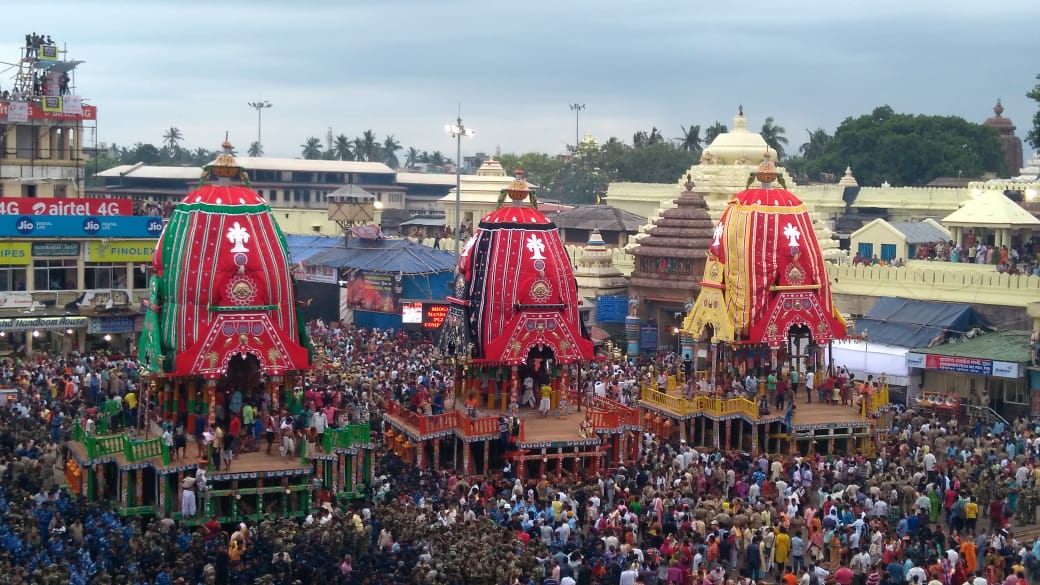KalingaTV News Network
By- Md. Mojahid Raza
Puri: The festive gala of Rath Yatra finally concluded on Wednesday with the ceremonial ‘Pahandi’ that marked the end of the festivities. Prior to the ceremony, the holy trinity were seated in their respective chariots on the grand road of Puri since three days. Servitors performed ‘mangala arati’, ‘abakash’ and offered fruits as ‘bhog’ to the devotees who had flocked there to seek the blessings of the holy deities. After the evening ‘Sandhya Dhupa’, preparations for ‘Pahandi’ kick started with the fixing of ‘chara-mara’ (ladders) to the chariots. This year, the ‘Pahandi’ ritual commenced one hour in advance, i.e at 5.10 pm.
Devotees and servitors celebrated this last leg of the chariot festival with great pomp and religious fervour. The excitement and joy was evidently palpable as everybody present had whipped themselves in a frenzy while anxiously trying to get a closer glimpse of the deities returning to their abode. Now it is only next year that the holy trinity would come out again.
Rath Yatra is not just any other festival. It is something which is very intrinsically related to Odia history, traditions and culture. With a history stretching across milleniums, the car festival finds mention in many ancient books and scriptures as well as accounts of foreign travellers.
Rath Yatra, also called Chariot Festival, is a Hindu festival celebrated annually in the temple town of Puri in Odisha. The Rath Yatra is associated with Lord Jagannath, who is an avatar of Lord Vishnu. The Car festival is held in the month of June-July every year and draws devotees and pilgrims from all across the country and abroad.
The festival is globally renowned and attracts more than one million people every year. The relevance of the festival has only increased over the centuries with people of all age groups equally revering Lord Jagannath.
Also, according to Hindu Mythology, Lord Krishna (in the incarnation of Lord Jagannath) would live in Puri in the Kali Yuga. Interestingly, this is the only time when those who are not allowed into the temple can get a chance to see the holy deities. This festival is a symbol of equality and integration. The three deities, Lord Jagannath, his elder brother Lord Balabhadra and their sister Subhadra are worshipped within the temple and on this festival they are taken to the streets of Puri so that everyone can have the fortune to see them.
The three deities make an annual journey to their aunt’s temple (Gundicha Temple), 2 km away from Lord Jagannath temple. The Jagannath temple in Puri is one among the four most sacred temples in India.
The festival of rath yatra begins with the invoking ceremony in the morning and the chariot pulling on the roads of Puri in afternoon is the most exciting part of this festival. There are three different chariots for three deities, the chariot of Lord Jagannath, Nandighosa has 18 wheels and is 45.6 feet high. The chariot of Lord Balabhadra, Taladhwaja has 16 wheels and is 45 feet high and the chariot of Subhadra, Devadalana has 14 wheels and is 44.6 feet high. Every year the wooden temples are constructed newly. The Idols of these three deities are also made of wood and they are religiously replaced by new ones in every 12 years, in an elaborate ceremony called ‘Nabakalebara’.
On the first day, if any chariot cannot reach the Gundicha Ghar, it is dragged on the next day. On the ninth day i.e. the return car festival day, the deities are brought to the Singhadawar area of the Jagannath temple. An important ritual performed, on the 5th day is known as the “Hera Panchami”, when goddess Laxmi proceeds towards Gundicha Ghar to see Lord Jagannath. In the evening of the 10th day, the deities are adorned with gold ornaments and dressed gorgeously in their respective chariots parked in the Singha Dwara area.
On the same day another ritual called “Hari Sayan Ekadashi” is performed. On the following day that is the 12th day of the bright fortnight, the important ceremony is known as “Adharapana Bhog” is performed. A sweet milk is offered to the deities. On the following day, the deities are taken to the temple in a traditional procession amidst gathering of thousands of devotees.
Apart from the religious point of view, Rath Yatra is an important part of Oriya culture and heritage. It stands for the harmony and symbolises the rich traditions of Odisha.




 Kalinga AI
Kalinga AI